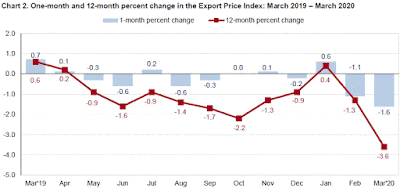Gross Domestic Product (GDP): First Estimate for Q1, 2020
Predicted: -5.0%
Actual: -4.8%
The yellow-highlighted percentage represents the first estimate of the quarter-to-quarter change for Real Gross Domestic Product for the entire United States.
From Today's Report: Coronavirus (COVID-19) Impact on First-Quarter 2020 GDP
Real GDP decreased 4.8 percent (annual rate) in the first quarter of 2020, following a 2.1 percent increase in the fourth quarter of 2019. The decline in first quarter GDP was, in part, due to the response to the spread of COVID-19, as governments issued “stay-at-home” orders in March. This led to rapid changes in demand, as businesses and schools switched to remote work or canceled operations, and consumers canceled, restricted, or redirected their spending. The full economic effects of the COVID-19 pandemic cannot be quantified in the GDP estimate for the first quarter of 2020
============
The GDP is a very broad measure of economic activity for the entire United States, covering all sectors of the economy. The Commerce Department defines real GDP as, "the output of goods and services produced by labor and property located in the United States."
============
============
Labels: Coronavirus, COVID-19, COVID19, GDP, gross_domestic_product, hard_data
|
--> www.FedPrimeRate.com Privacy Policy <--
> SITEMAP < |












